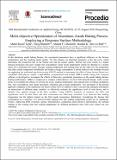Multi-objective Optimization of Aluminum Anode Baking Process Employing a Response Surface Methodology
Author(s)
Tajik, Abdul Raouf; Shamim, Tariq; Ghoniem, Ahmed F.; Abu Al-Rub, Rashid K.
DownloadPublished version (1008.Kb)
Publisher with Creative Commons License
Publisher with Creative Commons License
Creative Commons Attribution
Terms of use
Metadata
Show full item recordAbstract
© 2019 The Authors. Published by Elsevier Ltd. This is an open access article under the CC BY-NC-ND license (http://creativecommons.org/licenses/by-nc-nd/4.0/) Peer-review under responsibility of the scientific committee of ICAE2018 - The 10th International Conference on Applied Energy. In the aluminum anode baking furnace, the operational parameters have a significant influence on the furnace performance and the resulting anode quality. For this furnace, an important parameter is the fire-cycle, which determines the production rate of the baking kiln and the anodes quality. Shorter fire-cycle results in a higher furnace production rate and a higher fuel consumption (same anode temperature should be obtained in a shorter time). For a particular fire-cycle, flue-gas soaking temperature and soaking time are the other two key parameters that affect anode temperature distribution and furnace energy consumption. Limited studies in the literature focused on employing the traditional one-factor-a-time (OFAT) method to investigate the effect of these factors. Based on a simplified multi-physics model, a high-fidelity computational tool named ABKA (anode baking kiln analysis) software is developed to investigate the effects of these key operational parameters on the anode baking furnace heating performance. ABKA is employed to conduct a three-factors, two-level full factorial design, with a center point, to investigate the effects of varying fire-cycle, soaking temperature, and soaking time on furnace production rate, fuel consumption, and anode maximum, minimum and average temperature. The advantage of the present approach compared to the traditional one-factor-a-time (OFAT) method is that it can provide adequate information on interactions of different input variables, to effectively estimate the significance level of each factor, and to identify clear optimal settings of the three variables. Using ANOVA (analysis of variance), the effect and significance level of each factor and their interactions are effectively estimated. It is observed that soaking temperature has the highest impact on the final anode temperature distribution. Considering the furnace fuel consumption as a response, it is perceived that soaking time and soaking temperature jointly are as significant. Finally, employing RSM (response surface methodology), conducting multi-objective optimization, the optimal settings of the soaking time and soaking temperature for different production rates (fire-cycle values) are also estimated.
Date issued
2019-02Department
Massachusetts Institute of Technology. Department of Mechanical EngineeringJournal
Energy Procedia
Publisher
Elsevier BV
Citation
Tajik, Abdul Raouf, Shamim, Tariq, Ghoniem, Ahmed F. and Abu Al-Rub, Rashid K. 2019. "Multi-objective Optimization of Aluminum Anode Baking Process Employing a Response Surface Methodology." Energy Procedia, 158.
Version: Final published version
ISSN
1876-6102